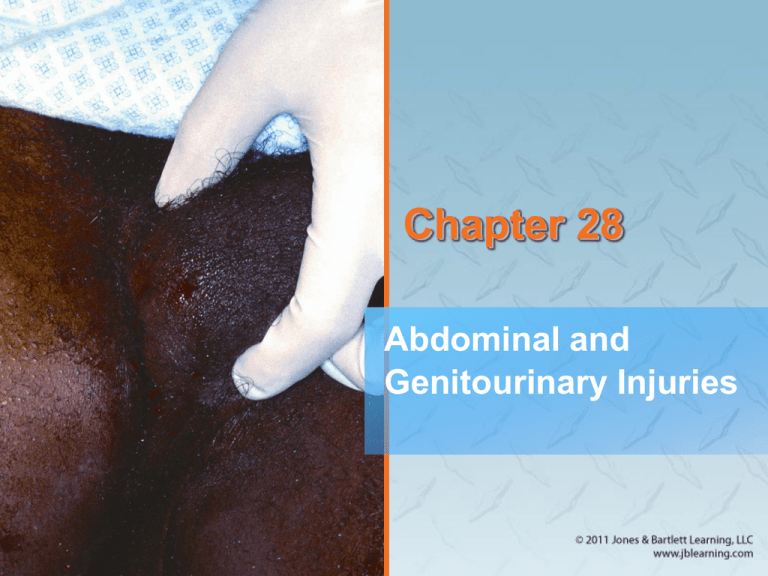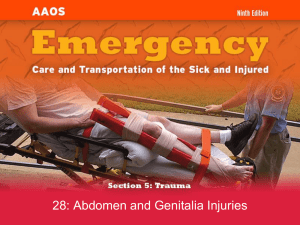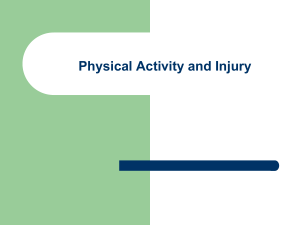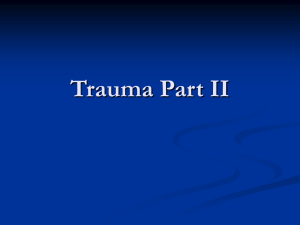
Chapter 28
Abdominal and
Genitourinary Injuries
National EMS Education
Standard Competencies (1 of 3)
Trauma
Applies fundamental knowledge to provide
basic emergency care and transportation
based on assessment findings for an acutely
injured patient.
National EMS Education
Standard Competencies (2 of 3)
Abdominal and Genitourinary Trauma
• Recognition and management of:
– Blunt versus penetrating mechanisms
– Evisceration
– Impaled object
• Pathophysiology, assessment, and
management of:
– Solid and hollow organ injuries
– Blunt versus penetrating mechanisms
National EMS Education
Standard Competencies (3 of 3)
Abdominal and Genitourinary Trauma
(cont’d)
• Pathophysiology, assessment, and
management of (cont’d):
– Evisceration
– Injuries to the external genitalia
– Vaginal bleeding due to trauma
– Sexual assault
Introduction (1 of 2)
• Abdomen is major body cavity extending
from diaphragm to pelvis.
– Contains organs that make up digestive,
urinary, and genitourinary systems.
• Important for EMT to know anatomy and
function of abdominal and pelvic cavities.
Introduction (2 of 2)
• 8% of significant trauma involves the
abdomen.
• Injuries to the abdomen that go
unrecognized or are not repaired in surgery
are a leading cause of traumatic death.
Anatomy and Physiology of the
Abdomen (1 of 9)
• Abdominal quadrants
– Abdomen is divided into four general quadrants.
• Right upper quadrant (RUQ)
• Left upper quadrant (LUQ)
• Right lower quadrant (RLQ)
• Left lower quadrant (LLQ)
– “Right” and “left” refer to patient’s right and left, not
yours.
Anatomy and Physiology of the
Abdomen (2 of 9)
• Quadrant of bruising/pain can delineate
which organs are involved.
– RUQ
• Liver, gallbladder, duodenum, pancreas
– LUQ
• Stomach and spleen
– LLQ
• Descending colon, left half of transverse colon
– RLQ
• Large and small intestine, the appendix
Anatomy and Physiology of the
Abdomen (3 of 9)
• RLQ is a common
location for
swelling and
inflammation.
• The appendix is a
source of infection
if it ruptures.
Anatomy and Physiology of the
Abdomen (4 of 9)
• Hollow organs
– Stomach, intestines, ureters, bladder
– Structures through which materials pass
• Most of these contain digested food, urine, or
bile.
Anatomy and Physiology of the
Abdomen (5 of 9)
• Hollow organs (cont’d)
– When ruptured or lacerated, contents spill into
peritoneal cavity.
• Can cause intense inflammatory reaction and
infection such as peritonitis
Anatomy and Physiology of the
Abdomen (6 of 9)
• Hollow organs (cont’d)
– Small intestine
• Duodenum, jejunum, and ileum
– Large intestine
• Cecum, colon, and rectum
– Intestinal blood supply comes from mesentery.
• Mesentery connects the small intestine to the
posterior of the abdominal wall.
Anatomy and Physiology of the
Abdomen (7 of 9)
Anatomy and Physiology of the
Abdomen (8 of 9)
• Solid organs
– Liver, spleen, pancreas, kidneys
• Solid masses of tissue
• Perform chemical work of the body: enzyme
production, blood cleansing, energy
production
• Because of rich blood supply, hemorrhage
can be severe.
Anatomy and Physiology of the
Abdomen (9 of 9)
Injuries to the Abdomen
• Injuries to the abdomen are considered
either open or closed.
– They can involve hollow and/or solid organs.
Closed Abdominal Injuries
(1 of 6)
• Blunt trauma to abdomen without breaking
the skin
– MOIs:
• Steering wheel
• Bicycle handlebars
• Motorcycle collisions
• Falls
Closed Abdominal Injuries
(2 of 6)
• MOIs (cont’d):
– Compression
• Poorly placed
lap belt
• Being run over
by a vehicle
– Deceleration
• Fast-moving
vehicle strikes
an immoveable
object.
Closed Abdominal Injuries
(3 of 6)
• Signs and symptoms
– Pain can be deceiving
• Often diffuse in nature
• May be referred to another body location
(such as the Kehr sign)
– Blood in peritoneal cavity produces acute pain
in entire abdomen.
Closed Abdominal Injuries
(4 of 6)
• Signs and symptoms (cont’d)
– Difficult to determine location of pain.
• Guarding: stiffening of abdominal muscles
• Abdominal distention: result of free fluid,
blood, or organ contents spilling into
peritoneal cavity
• Abdominal bruising and discoloration
• May appear as abrasions initially
Closed Abdominal Injuries
(5 of 6)
• Seatbelts
– Prevent many injuries and save lives.
• May cause blunt injuries of abdominal organs
– Particularly when belt lies too high
• Can cause bladder injuries to pregnant
patients
• Air bags
– Air bags are a great advancement.
• Must be used in combination with safety belts
Closed Abdominal Injuries
(6 of 6)
Open Abdominal Injuries (1 of 6)
• Foreign object enters abdomen and opens
peritoneal cavity to outside.
– Also called penetrating injuries
– Examples: stab wounds, gunshot wounds
– Open wounds can be deceiving.
• Maintain a high index of suspicion.
Open Abdominal Injuries (2 of 6)
• Injury depends on velocity of object.
– Low-velocity injuries
• Knives, other edged weapons
– Medium-velocity injuries
• Smaller caliber handguns and shotguns
– High-velocity injuries
• High-powered rifles and handguns
Open Abdominal Injuries (3 of 6)
• High- and medium-velocity injuries
– Have temporary wound channels
– Caused by cavitation
• Cavity forms as pressure wave from projectile
transfers to tissues.
• Can produce large amounts of bleeding
Open Abdominal Injuries (4 of 6)
• Low-velocity injuries
– Also have capacity to damage organs
– Internal injury may not be apparent.
– Injury at or below xiphoid process
• Assume it has affected the thoracic and
peritoneal cavities.
Open Abdominal Injuries (5 of 6)
• Evisceration: bowel protrudes from
peritoneum.
– Can be painful and visually shocking
– Do not push down on abdomen.
– Only perform visual assessment.
– Cut clothing close to wound.
– Never pull on clothing stuck to or in the wound
channel.
Open Abdominal Injuries (6 of 6)
• Signs and symptoms
– Pain
– Tachycardia
• Heart increases pumping action to
compensate for blood loss
– Later signs include:
• Evidence of shock
• Changes in mental status
• Distended abdomen
Hollow Organ Injuries (1 of 2)
• Often have delayed signs and symptoms
• Spill contents into abdomen
– Infection develops, which can take hours or
days.
– Stomach and intestines can leak highly toxic
and acidic liquids into peritoneal cavity.
Hollow Organ Injuries (2 of 2)
• Both blunt and penetrating trauma can
cause hollow organ injuries
– Blunt: causes organ to “pop”
– Penetrating: causes direct injury
• Gallbladder and urinary bladder
– Contents are damaging.
• Air in peritoneal cavity causes pain.
– Can cause ischemia and infarction
Solid Organ Injuries (1 of 5)
• Can bleed significantly and cause rapid
blood loss
– Can be hard to identify from physical exam
– Slowly ooze blood into peritoneal cavity
Solid Organ Injuries (2 of 5)
• Liver is the largest organ in abdomen.
– Vascular, can lead to hypoperfusion
• Often injured by fractured lower right rib or
penetrating trauma
• Kehr sign is common finding with injured
liver.
Solid Organ Injuries (3 of 5)
• Spleen and pancreas
– Vascular and prone to heavy bleeding
– Spleen is often injured.
• Motor vehicle collisions
• Steering wheel trauma
• Falls from heights
• Bicycle and motorcycle accidents involving
handlebars
Solid Organ Injuries (4 of 5)
• Diaphragm
– When penetrated or ruptured, loops of bowels
invade thoracic cavity.
• May cause bowel sounds during auscultation
of lungs
• Patient may exhibit dyspnea.
Solid Organ Injuries (5 of 5)
• Kidneys
– Can cause significant blood loss
– Common finding is blood in urine (hematuria).
– Blood visible on urinary meatus indicates
significant trauma to genitourinary system.
Patient Assessment of
Abdominal Injuries (1 of 2)
• Assessment of abdominal injuries is difficult.
– Causes of injury may be apparent, but resulting
tissue damage may not be.
– Patient may be overwhelmed with more painful
injuries.
– Some injuries develop and worsen over time,
making reassessment critical.
Patient Assessment of
Abdominal Injuries (2 of 2)
• Patient assessment steps
– Scene size-up
– Primary assessment
– History taking
– Secondary assessment
– Reassessment
Scene Size-up (1 of 2)
• Scene Safety
– Information from dispatch may be sketchy or
vague.
– Standard precautions of gloves and eye
protection should be a minimum
– Be sure scene is safe for you
• If assault, domestic dispute, or drive-by
shooting is indicated, ensure police have
secured the area
Scene Size-up (2 of 2)
• Mechanism of injury/nature of illness
– Observe the scene for early indicators of MOI
– Consider early spinal precautions
– If the wound is penetrating, inspect object of
penetration
Primary Assessment (1 of 5)
• Evaluate patient’s ABCs.
– Perform rapid scan.
• Helps establish seriousness of condition
– Some injuries will be obvious and graphic.
• Others will be subtle and go unnoticed.
– Injury may have occurred hours or days earlier.
Primary Assessment (2 of 5)
• Form a general impression.
– Important indicators will alert you to seriousness
of condition.
– Don’t be distracted from looking for more
serious hidden injuries.
– Check for responsiveness using AVPU scale.
Primary Assessment (3 of 5)
• Airway and breathing
– Ensure airway is clear and patent.
– Check for spinal injury.
– Clear airway of vomitus.
• Note the nature of the vomitus.
– A distended abdomen may prevent adequate
inhalation.
• Providing oxygen will help improve
oxygenation.
Primary Assessment (4 of 5)
• Circulation
– Superficial abdominal injuries usually do not
produce significant external bleeding.
– Internal bleeding can be profound.
• Trauma to liver, kidneys, and spleen can
cause significant internal bleeding.
• Evaluate pulse, skin color, temperature, and
condition to determine stage of shock.
• Treat aggressively.
Primary Assessment (5 of 5)
• Transport decision
– Abdominal injuries generally indicate a quick
transport to the hospital.
• Delay in medical evaluation may result in
unnecessary and dangerous progression of
shock.
• Patients with abdominal injuries should be
evaluated at the highest level of trauma
center available.
History Taking (1 of 2)
• Investigate chief complaint.
– Further investigate MOI.
– Identify signs, symptoms, and pertinent
negatives.
– Movement of body or abdominal organs irritates
peritoneum, causing pain.
• To minimize this pain, patients will lie still with
knees drawn up.
History Taking (2 of 2)
• SAMPLE history
– Use OPQRST to help explain injury.
– If patient is not responsive, obtain history from
family or friends.
– Ask if there is nausea, vomiting, or diarrhea.
– Ask about appearance of any bowel movements
and urinary output.
Secondary Assessment (1 of 6)
• May not have time to perform in field
• Physical examinations
– Inspect for bleeding.
– Remove or loosen clothes to expose injuries.
• Provide privacy.
– Patient should remain in position of comfort.
• Relieves tension
Secondary Assessment (2 of 6)
• Physical examinations (cont’d)
– Examine entire abdomen.
• Critical step for patients with entrance wound
– Evaluate the bowel sounds.
• Can be difficult to hear
• Hypoactive = cannot hear sounds
• Hyperactive = lots of gurgling and gas
moving about
Secondary Assessment (3 of 6)
• Physical examinations (cont’d)
– Use DCAP-BTLS.
• Inspect and palpate for deformities.
• Look for presence of contusions, abrasions,
puncture wounds, penetrating injuries, burns.
• Palpate for tenderness and attempt to
localize to specific quadrant of abdomen.
• Swelling may indicate significant intraabdominal injury.
Secondary Assessment (4 of 6)
• Physical examinations (cont’d)
– Palpate farthest away from quadrant exhibiting
signs of injury and pain.
• Allows you to investigate possibility of
radiation of pain
– Perform full-body scan to identify injuries.
• Begin with head and finish with lower
extremities.
• If you find life threat, stop and treat it.
Secondary Assessment (5 of 6)
• Physical examinations (cont’d)
– If MOI suggests isolated injury, focus physical
exam on injured area.
• Inspect for entrance and exit wounds.
• Do not remove impaled objects.
– Inspect and palpate kidney area for tenderness,
bruising, swelling, or other trauma signs.
• Hollow organs will spill contents into
peritoneal cavity.
Secondary Assessment (6 of 6)
• Vital signs
– Many abdominal emergencies can cause a
rapid pulse and low blood pressure.
– Record of vital signs will help identify changes
in condition.
– Use appropriate monitoring devices.
Reassessment (1 of 3)
• Repeat the primary assessment and
reassess vital signs.
– Reassess interventions and treatment.
• Interventions
– Manage airway and breathing problems.
– Provide spinal stabilization.
– Treatment for shock
– Cover wounds
Reassessment (2 of 3)
• Communication and documentation
– Communicate all relevant information to staff at
receiving hospital.
– Use appropriate medical and anatomic
terminology.
• When in doubt, describe what you see.
– Document results of physical exam and
pertinent negatives.
• Also document any steps that were skipped.
Reassessment (3 of 3)
• Communication and documentation (cont’d)
– Describe scene in enough detail to give trauma
team a clear understanding.
– Be cautious and diligent when dealing with
patients who refuse transport.
• These patients are at high risk for
complications.
Emergency Medical Care of
Abdominal Injuries (1 of 7)
• Closed abdominal injuries
– Biggest concern is not knowing the extent of
injury.
• Patient requires expedient transport.
– Primarily to trauma center with surgeon
• Position for comfort
• Apply high-flow oxygen.
• Treat for shock.
Emergency Medical Care of
Abdominal Injuries (2 of 7)
• Closed abdominal injuries (cont’d)
– Patient with blunt abdominal wounds may have:
• Severe bruising of abdominal wall
• Liver and spleen laceration
• Rupture of intestine
• Tears in mesentery
• Rupture of kidneys or avulsion of kidneys
Emergency Medical Care of
Abdominal Injuries (3 of 7)
• Closed abdominal injuries (cont’d)
– Patient with blunt abdominal injury should be
log rolled to a supine position on a backboard.
– Protect the spine.
– Monitor vital signs.
Emergency Medical Care of
Abdominal Injuries (4 of 7)
• Open abdominal injuries
– Patients with penetrating injuries
• Generally obvious wounds, external bleeding
• High index of suspicion for serious unseen
blood loss
• Surgeon will assess damage.
Emergency Medical Care of
Abdominal Injuries (5 of 7)
• Open abdominal injuries (cont’d)
– Inspect patient’s back and sides for exit wound.
– Apply dry, sterile dressing to all open wounds.
– If penetrating object is still in place, apply
stabilizing bandage around it.
Emergency Medical Care of
Abdominal Injuries (6 of 7)
• Open abdominal
injuries (cont’d)
– Evisceration
• Severe
lacerations of
abdominal wall
may result in
internal organs
or fat protruding
through wound.
Emergency Medical Care of
Abdominal Injuries (7 of 7)
• Open abdominal injuries (cont’d)
– Never try to replace a protruding organ.
• Keep the organs moist and warm.
• Cover with moistened, sterile gauze or
occlusive dressing.
• Secure dressing with bandage.
• Secure bandage with tape.
Anatomy of the Genitourinary
System (1 of 3)
• Controls reproductive functions and waste
discharge
– Generally considered together
– Male genitalia lie outside pelvic cavity.
• Except prostate gland and seminal vesicles
– Female genitalia lie within pelvic cavity.
• Except vulva, clitoris, labia
Anatomy of the Genitourinary
System (2 of 3)
Anatomy of the Genitourinary
System (3 of 3)
Injuries of the Genitourinary
System (1 of 8)
• Kidney injuries
– Rarely seen but not unusual
– Kidneys lie in well-protected area.
• Forceful blow or penetrating injury often
involved
Injuries of the Genitourinary
System (2 of 8)
• Suspect kidney damage if patient has a
history or physical evidence of any of the
following:
• Abrasion, laceration, contusion in the flank
• Penetrating wound in region of flank or upper
abdomen
• Fractures on either side of lower rib cage or
of lower thoracic or upper lumbar vertebrae
• A hematoma in the flank region
Injuries of the Genitourinary
System (3 of 8)
Injuries of the Genitourinary
System (4 of 8)
• Urinary bladder injuries
– May result in rupture
• Urine spills into surrounding tissues.
• Blunt injuries to lower abdomen or pelvis can
rupture urinary bladder.
– In males, sudden deceleration can shear the
bladder from the urethra.
– In later trimesters of pregnancy, bladder injuries
increase.
Injuries of the Genitourinary
System (5 of 8)
Injuries of the Genitourinary
System (6 of 8)
• External male genitalia injuries
– Soft-tissue wounds
– Painful and of great concern for patient
• Rarely life threatening
• Should not be given priority over more severe
wounds
Injuries of the Genitourinary
System (7 of 8)
• Female genitalia injuries
– Internal female genitalia
• Uterus, ovaries, fallopian tubes are rarely
damaged.
• Exception is pregnant uterus
– Uterus enlarges substantially and rises out of
pelvis
– Injuries can be serious.
– Also keep fetus in mind.
– In last trimester of pregnancy, uterus is large and
may obstruct vena cava.
Injuries of the Genitourinary
System (8 of 8)
• Female genitalia injuries (cont’d)
– External female genitalia
• Vulva, clitoris, major and minor labia
• Very rich nerve supply
• Consider sexual assault and pregnancy.
• If there is external bleeding, a sterile
absorbent sanitary pad may be applied to the
labia.
• Do not insert anything into the vagina.
Patient Assessment of the
Genitourinary System (1 of 2)
• Potential for patient embarrassment
– Maintain a professional presence.
– Provide privacy .
– Have EMT of same gender perform
assessment.
– Look for blood on patient’s undergarments.
Patient Assessment of the
Genitourinary System (2 of 2)
• Patient assessment steps
– Scene size-up
– Primary assessment
– History taking
– Secondary assessment
– Reassessment
Scene Size-up (1 of 2)
• Scene safety
– Assess the scene for hazards and threats.
– Assess the impact of hazards on care.
– Assess for the potential for violence and
environmental hazards.
– At minimum, gloves and eye protection are
required.
Scene Size-up (2 of 2)
• Mechanism of injury/nature of illness
– Look for indicators of MOI.
• Consider how MOI produced the injuries
expected.
• Patient may avoid the discussion to avoid
undergoing a physical exam.
• Patient may also provide an MOI that seems
less embarrassing than the actual MOI.
Primary Assessment (1 of 5)
• Quickly scan patient to identify any treat life
threats.
– Genitourinary system is very vascular.
• Injuries can produce significant volume of
blood.
– Do not avoid this area in the rapid scan.
• If bleeding is present, inspect exterior
genitals for visible injury.
Primary Assessment (2 of 5)
• Form a general impression.
– Important indicators will alert you to the
seriousness of the condition.
• Is the patient awake and interacting?
• Are there any life threats?
• What color is the patient’s skin?
• Is he or she responding appropriately or
inappropriately?
Primary Assessment (3 of 5)
• Airway and breathing
– Ensure the patient has a clear and patent
airway.
• Protect from further spinal injury.
– Consider advanced airway if patient is
unresponsive.
• Circulation
– Genitourinary system can be a significant
source of bleeding.
Primary Assessment (4 of 5)
• Circulation (cont’d)
– Assess pulse rate and quality.
– Determine skin condition, color, and temp.
– Check capillary refill time.
• Closed injuries do not have visible signs of
bleeding.
• Control bleeding if seen.
Primary Assessment (5 of 5)
• Transport decision
– Any injury to the genitourinary system can be
life altering.
• Often, injuries require medical specialist for
specialized care.
History Taking (1 of 2)
• Investigate chief complaint.
– Determine why 9-1-1 was called.
– Common associated complaints with
genitourinary injuries are:
• Nausea and vomiting
• Diarrhea
• Blood in urine
• Vomiting blood
• Abnormal bowel and bladder habits
History Taking (2 of 2)
• SAMPLE history
– Use OPQRST to learn about patient’s pain.
– Ask patient about output.
• Especially urine in blood
– Ask about allergies.
– The importance of past medical history cannot
be overstated.
– Ask when was last intake of food and fluid.
– Address events leading up to injury.
Secondary Assessment (1 of 3)
• Physical examinations
– Genitourinary system injuries can be awkward
to assess and treat.
• Privacy is a genuine concern.
– Focus on specific region of body when isolated
injury is present.
– Look for DCAP-BTLS.
– Identify wounds and control bleeding.
Secondary Assessment (2 of 3)
• Physical examinations (cont’d)
– Start with a full-body scan for significant trauma.
• Presence of penetrating injury indicates
possible internal injury.
• Presence of burns must be noted and
managed immediately.
• Palpate for tenderness to localize the injury
and presence of fractures.
• Look for lacerations and local swelling.
Secondary Assessment (3 of 3)
• Vital signs
– Obtain the patient’s vital signs
• Important to reassess vital signs to identify
differences in condition.
• Tachycardia; tachypnea; low blood pressure;
weak pulse; and cool, moist, pale skin
indicate hypoperfusion.
• Use pulse oximetry and noninvasive blood
pressure devices when available.
Reassessment
• Interventions
– Provide oxygen and maintain airway.
– Control bleeding and treat for shock.
– Place patient in position of comfort and
transport.
• Communication and documentation
– Communicate all concerns to hospital staff.
– Describe and document all injuries and
treatments given.
Emergency Medical Care of
Genitourinary Injuries (1 of 12)
• Kidney injuries
– Injuries may not be obvious.
• However, you will see:
– Signs of shock
– Blood in urine (hematuria)
– Treat for shock, transport promptly, monitor vital
signs en route.
Emergency Medical Care of
Genitourinary Injuries (2 of 12)
• Urinary bladder injury
– Suspect if you see:
• Blood at urethral opening
• Signs of trauma to lower abdomen, pelvis,
perineum
– In presence of shock or associated injuries:
• Transport promptly.
• Monitor vital signs en route.
Emergency Medical Care of
Genitourinary Injuries (3 of 12)
• External male genitalia
– General rules for treatment:
• Make patient comfortable.
• Use sterile, moist compresses to cover areas
stripped of skin.
• Apply direct pressure with dry, sterile gauze
dressings to control bleeding.
• Never move or manipulate foreign objects in
urethra.
Emergency Medical Care of
Genitourinary Injuries (4 of 12)
• External male genitalia (cont’d)
– General rules for treatment (cont’d):
• Identify and take avulsed parts in bag to
hospital with patient.
– Amputation of penile shaft
• Managing blood loss is top priority.
– Use local pressure with sterile dressing.
Emergency Medical Care of
Genitourinary Injuries (5 of 12)
• External male genitalia (cont’d)
– If connective tissue surrounding erectile tissue
is damaged, shaft can be fractured or angled.
• Sometimes requires surgical repair
• Injury may occur during active sexual
intercourse.
• Associated with intense pain, bleeding, and
fear
Emergency Medical Care of
Genitourinary Injuries (6 of 12)
• External male genitalia (cont’d)
– Laceration of head of penis
• Associated with heavy bleeding
• Apply local pressure with sterile dressing.
– Skin of shaft or foreskin caught in zipper
• If small segment of zipper is involved, try to
unzip.
• If long segment of zipper is involved, cut the
zipper out of the pants with heavy scissors.
Emergency Medical Care of
Genitourinary Injuries (7 of 12)
• External male genitalia (cont’d)
– Urethral injuries are not uncommon
• Straddle injuries, pelvic fractures, and
penetrating wounds of the perineum
• Important to know if patient can urinate and if
there is blood in urine
– Save urine for hospital examination.
• Foreign bodies protruding from urethra will
have to be surgically removed.
Emergency Medical Care of
Genitourinary Injuries (8 of 12)
• External male genitalia (cont’d)
– Avulsion of the skin of the scrotum may damage
scrotal contents.
• Preserve avulsed skin in a moist sterile
dressing.
• Wrap scrotal contents or perineal area with a
sterile moist compress; use local pressure for
bleeding.
– Direct blows to scrotum can result in rupture of a
testicle or accumulation of blood around testes.
• Apply ice to scrotal area.
Emergency Medical Care of
Genitourinary Injuries (9 of 12)
• Female genitalia
– Treat lacerations and avulsions with moist,
sterile compresses.
• Use local pressure to control bleeding.
• Hold dressings in place with diaper-type
bandage.
– Do not pack dressings into vagina.
Emergency Medical Care of
Genitourinary Injuries (10 of 12)
• Female genitalia (cont’d)
– Leave any foreign bodies in place after
stabilizing with bandages.
– Injuries are painful but not life threatening.
• In-hospital evaluation required.
• Transport urgency determined by associated
injuries, amount of hemorrhage, presence of
shock.
Emergency Medical Care of
Genitourinary Injuries (11 of 12)
• Rectal bleeding
– Common complaint
• May present as blood in or soaking through
undergarments
– Possible causes include sexual assault,
hemorrhoids, colitis, ulcers.
• Rectal bleeding possible after hemorrhoid
surgery
Emergency Medical Care of
Genitourinary Injuries (12 of 12)
• Rectal bleeding (cont’d)
– Acute rectal bleeding should never be passed
off as something minor.
• Pack crease between buttocks with
compresses.
• Consult medical control to determine need for
transport.
Sexual Assault (1 of 4)
• Sexual assault and rape are common.
• Victims are generally women.
– Sometimes men and children
– Often little you can do beyond providing
compassion and transport.
– Patient may have sustained multisystem
trauma.
• Will need treatment for shock.
Sexual Assault (2 of 4)
• Do not examine genitalia unless obvious
bleeding requires application of dressing.
• Follow appropriate procedures and
protocol.
– Shield patient from curious onlookers.
– Document patient’s history, assessment,
treatment, and response to treatment.
Sexual Assault (3 of 4)
• Follow crime scene policy of your EMS
system.
– Advise patient not to wash, douche, urinate, or
defecate until after examination.
– If oral penetration occurred, advise patient not
to eat, drink, brush the teeth, or use mouthwash
until after examination.
– Handle patient’s clothes as little as possible.
Sexual Assault (4 of 4)
• Make sure EMT caring for patient is same
gender as patient whenever possible.
• Treat medical injuries and provide privacy,
support, reassurance.
Summary (1 of 9)
• Abdominal injuries are categorized as either
open (penetrating trauma) or closed (blunt
force trauma).
• Either injury can result in injury to the hollow
or solid organs of the abdomen.
Summary (2 of 9)
• Blunt force trauma that causes closed
injuries results from an object striking the
body without breaking the skin.
• Penetrating trauma is often a result of a
gunshot wound or stab wound and breaks
the skin.
Summary (3 of 9)
• Injury to the solid internal organs often
causes significant unseen bleeding that can
be life threatening.
• Injury to the hollow organs of the abdomen
may cause irritation and inflammation to the
peritoneum as caustic digestive juices leak
into the peritoneum.
Summary (4 of 9)
• Always maintain a high index of suspicion
for serious intra-abdominal injury in the
trauma patient, particularly in the patient
who exhibits signs of shock.
Summary (5 of 9)
• Assess the abdomen for signs of bruising,
rigidity, penetrating injuries, and complaints
of pain.
• Never remove an impaled object from the
abdominal region.
Summary (6 of 9)
• Be prepared to treat the patient for shock.
• Never replace an organ that protrudes from
an open injury to the abdomen
(evisceration).
Summary (7 of 9)
• Injuries to the kidneys may be difficult to
detect because of their location. Be alert to
bruising or a hematoma in the flank region.
• Injury to the external genitalia of male and
female patients is very painful but not
usually life threatening.
Summary (8 of 9)
• In the case of sexual assault or rape, treat
for shock if necessary, and record all the
facts in detail.
• Follow any crime scene policy established
by your system to protect the scene and
any potential evidence.
Summary (9 of 9)
• Advise the patient not to wash, douche, or
void until after a physician has examined
him or her.










